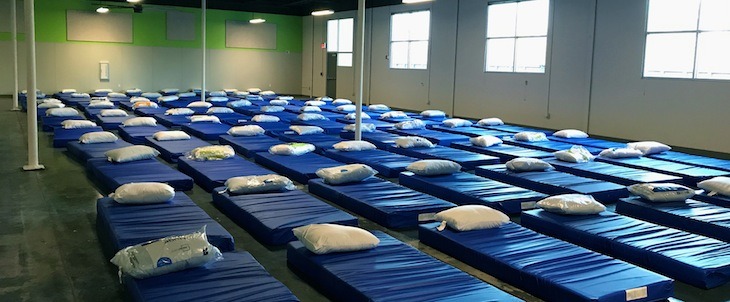Fort Smith homeless shelter director talks measuring success, ‘making homelessness easy’
by September 26, 2017 6:01 pm 2,694 views

The Riverview Hope Campus opened Sept. 29, 2017.
The Riverview Hope Campus opens on Friday (Sept. 29) after approximately eight years of planning and development. The effort behind the $3.9 million campus — bringing together various agencies in the Fort Smith region to provide services to the city’s homeless population — hit the home stretch in March after bringing on Executive Director Chris Joannides.
Joannides leads a team that consists of a donor development director, case manager, three interns, chef, two security guards, and two intake coordinators. The 127,500-square foot facility — a former furniture factory at 301 South E St. — will open with a barbershop, laundry room, worship center, and two large shower-ready bathrooms.
Hope Campus projections, according to a January 2017 “point-in-contact” study revealed the homeless population to be around 188 individuals. Joannides told Talk Business & Politics that “about half” were unsheltered at that time — “couch surfing, living in my backyard at the camp sites.” Assuming 94 unsheltered homeless persons, the 105-bed facility should be able to “fill the doors and cure homelessness” on Friday, Joannides said, “but I’m not that naive. I wish we were that good, but there is such thing as chronic homeless, chronic alcoholics, chronic mental disorders. It will be a constant flow.”
MEASURING SUCCESS
The site received its funding through a variety of sources — $695,000 in grants from the Arkansas Development Finance Authority, $603,441 in Community Development Block Grants through the city of Fort Smith, a $500,000 grant from the Federal Home Loan Bank of Dallas, and hundreds of thousands in donations and in-kind services from the public, including $100,000 from the Griffin Family of Fort Smith and, just last month, an additional $5,000 contribution from BancorpSouth. Also, Mercy-Fort Smith committed $350,000 to help build and staff a clinic inside the building, and Joannides will continue to pursue grant opportunities through state and federal funding sources to help defray costs on the annual operating budget of “just under $500,000.”
“And that’s everything,” Joannides added — “feeding, staffing, everything.”
He expects the facility will serve around 200 meals per day. With ongoing expenses and several current and future stakeholders involved, accountability will be critical, Joannides acknowledged, noting Hope Campus’s success “will be measured on reducing homelessness and getting people back to self-sufficiency.”
“Our model is not a handout model by any means. We have a baseline of a 90- or 120-day reprieve; then they’re back into working, renting their apartment, paying taxes, buying gasoline, buying groceries, and back to being productive members of society.”

The facility operates on what Joannides calls “the four pillars:” education, employment, housing and health.
“If we can address those four items, our chances are a whole lot better. Mercy Clinic will be one of our anchor partners. They will have a full-fledged clinic that takes insurance, Medicare, Medicaid, stuff like that.” On the education side, the facility will offer continuing education courses that include GED and English as a Second Lanuage (or ESL). It will also feature classes on parenting, domestic violence, how to prepare a resume, and “anything that’s going to help them when applying for interviews — how to act and talk in an interview, how to dress in an interview.”
The site will also feature a stylist and laundry facility because “you can’t get a job if you’re dirty and nasty,” Joannides said, adding that “everything” that goes on at Hope Campus will be tracked.
“If you come in here just to eat, I’m going to know if you ate here 200 times, or if you showered 100 times and ate 200 times and maybe used my laundry facility 50 times. And we’ll be compiling all that and looking at it every 90 days. I mean … if we’re missing a trend, we probably need to look and see what makes sense, or if we’re not addressing this issue, how can we?”
A COMMUNITY EFFORT
With the opening only a few days away, Joannides emphasized that for Hope Campus to be successful, it “can’t just be about my love for the homeless; it will have to be a community effort.”
To help bring more into the mission, staff will be reaching out to businesses and organizations in downtown Fort Smith where most of the area’s homeless population resides to spread the word. There will also be continuing outreach efforts with the Old Fort Homeless Coalition, the group that originally championed the Hope Campus’s creation. Additionally, the campus is in communications with the Fort Smith Police Department (FSPD), who are “helping to let the campsites know about us.”
“The next phase is to go out into the community and work with businesses, and to apply for state and federal grants. But a lot of it will depend on the community, just to be frank,” Joannides said, adding that with public intoxication arrests, police can end up housing 20 homeless people every night, “and it’s the same people.”
How are they getting alcohol if they can’t afford shelter?
“Our lovely public donates to them when they’re out there standing on the street corner. It’s a hard mindset to change because for the most part, we’re all god-fearing people, but sometimes helping hurts, and we’re not doing society any favors. If you give me $5 as a homeless person, that’ll feed me, yes; but if you give $5 to Hope Campus, I can feed four or five people. I can buy in volume. I pay no more than 19 cents a pound for my meat through the River Valley Food Bank. That can feed a lot of people.”
Joannides continued: “Sometimes we as a community, we can make homelessness easy. Our goal, instead of feeding the homeless down on the river, let’s direct them here.” Otherwise, “All we’re doing is prolonging the problem.”
